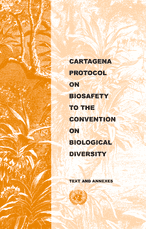Cartagena Protocol on Biosafety to the Convention on Biological Diversity
The Cartagena Protocol on Biosafety to the Convention on Biological Diversity governs the transnational movement of living modified organisms (LMOs), often referred to colloquially as genetically modified organisms (GMOs). The treaty allows countries to manage and restrict the introduction of LMOs into their ecosystems through Advanced Informed Agreements. Article 20 established a Biosafety Clearing-House, which documents national records related to biosafety laws, risk assessments, and other content; reference records from biosafety organizations, laboratories, and other non-governmental parties, and documents from the CBD Secretariat.
| Opened for signature | 29 Jan 2000 |
| Entered into force | 11 Sep 2003 |
| Latest update | 29 Jan 2000 |
| Available languages |
Related treaties
States parties
Countries automatically become a party to the Cartagena Protocol 90 days after depositing their instrument of ratification, acceptance, approval or accession. Download the data in this table to view any reservations, understandings, and declarations (RUDs).
Country | Status | Signed | Ratified | Entered into force |
|---|---|---|---|---|
| Afghanistan | Party | 20 Feb 2013 | 21 May 2013 | |
| Albania | Party | 8 Feb 2005 | 9 May 2005 | |
| Algeria | Party | 25 May 2000 | 5 Aug 2004 | 3 Nov 2004 |
| Andorra | Non-party | |||
| Angola | Party | 27 Feb 2009 | 28 May 2009 | |
| Antigua and Barbuda | Party | 24 May 2000 | 10 Sep 2003 | 9 Dec 2003 |
| Argentina | Signatory | 24 May 2000 | ||
| Armenia | Party | 30 Apr 2004 | 29 Jul 2004 | |
| Australia | Non-party | |||
| Austria | Party | 24 May 2000 | 27 Aug 2002 | 11 Sep 2003 |
Party
The state has accepted, approved, ratified, or is otherwise party to the agreement, indicating consent to be bound to the agreement.
Signatory
The state has signed, but not yet ratified or become an official party to the agreement. Where the signature is subject to ratification, acceptance or approval, the signature does not establish the consent to be bound. However, it is a means of authentication and expresses the willingness of the signatory state to continue the treaty-making process. The signature qualifies the signatory state to proceed to ratification, acceptance or approval. It also creates an obligation to refrain, in good faith, from acts that would defeat the object and the purpose of the agreement.
Non-party
The state has not taken any actions with regard to the agreement.
Associate member
The state may have requirements for some of the statutory or non statutory aspects of an agreement, but would not confer all of the obligations of the agreement on the member. Associate members may not have voting rights.
Observer
The state is non-party to an agreement, but has the ability to attend meetings or other discussions, and otherwise participate in activities. Observers may be granted permission to speak at formal meetings.




